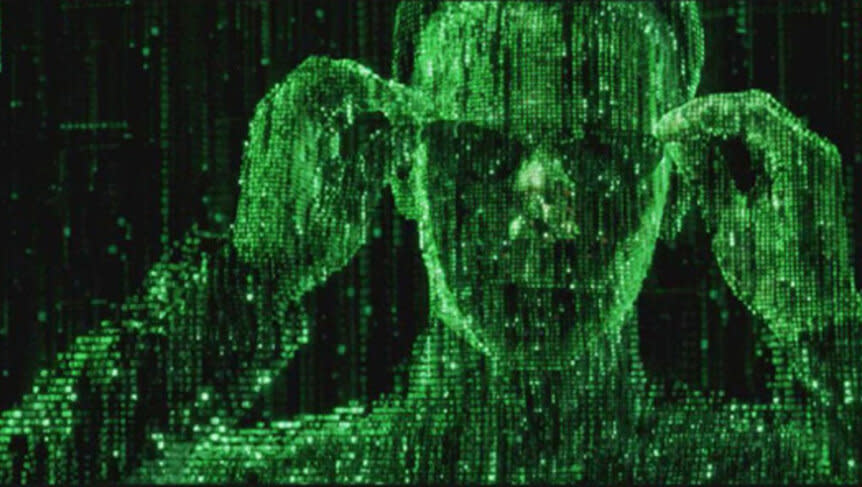Does a New “Law of Physics” Prove We Live in a Simulation?
The early ‘90s were an exciting time, full of promise and expectation. The new millennium was on the horizon and emerging home computer technology was connecting people all over the world in entirely new ways. Cyberspace was a digital wild west, untapped and lawless. It’s in that landscape that viewers were introduced to in The Lawnmower Man (streaming now on Peacock). The story follows Dr. Lawrence Angelo (Pierce Brosnan), a scientist experimenting with a combination of virtual reality and psychoactive drugs to push humanity into a brave (if horrifying) new digital age.
In the real world, virtual reality is still a developing technology, only recently becoming viable as a means of entertainment, if not world domination. The idea of existing in an entirely virtual space still sounds like science fiction… unless a contingent of scientists are right about their suggestion that our entire universe is a virtual one.
Is Reality Actually Real or Are We in a Simulation?

Credit: Warner Bros.
It’s an argument people have been making, in various forms, throughout history. René Descartes famously wrote the words “cogito, ergo sum” (I think, therefore I am) back in 1637, noting that we can’t really know that anything we experience is real, except that we are experiencing it.
RELATED: Could We Be Living in a Simulation? The Science Behind The Matrix
To date, most arguments that we’re living in a simulation rely on logic or math to make a statistical argument about the probability that our universe is “real.” The idea, simply put, goes something like this: We may one day be able to create simulations of the universe with advanced computers. If so, we’ll likely create more than one simulation, and we won’t be the only ones. Ultimately, you’ll have a countless number of universes, all but one of which are simulated. And the odds that we happen to be living in the one real universe are vanishingly small.
However, because any such simulation would be almost totally indistinguishable from reality, testing it might be impossible. And if it’s untestable, it’s not science. Enter, Melvin Vopson and Serban Lepadatu — a physicist from the University of Portsmouth and mathematician from the Jeremiah Horrocks Institute for Mathematics, Physics and Astronomy — two scientists who have proposed a new law of physics with the potential to find out if we’re in a simulation once and for all.
Probing the Simulation with the Second Law of Infodynamics

Digital rendering close-up of DNA helix with shallow depth of field and a blue background. Photo: OsakaWayne Studios/Getty Images
Vopson and Lepadatu proposed the Second Law of Information Dynamics (infodynamics) in 2022 as a new way of quantifying information in the universe. It plays on Newton’s Second Law of Thermodynamics which states that entropy (disorder) in a closed system must remain stable or increase over time. The Second Law of Infodynamics proposed a similar relationship with information entropy which Vopson and Lepadatu put to the test.
In a new study, published in the journal AIP Advances, researchers tested a number of information systems with an eye toward how information is maintained or lost over time. They applied their new law to digital information, genetic information, atomic physics, mathematical symmetries, and cosmology and found that, contrary to expectations, information entropy works in the opposite direction as physical entropy. They expected information systems to become increasingly chaotic, like matter and energy do, but instead they found that information entropy remained stable or decreased over time.
RELATED: How Do You Escape the Matrix?
As part of their study, Vopson and Lepadatu looked at RNA sequences in variants of SARS-CoV-2 (commonly called Covid) and found that information entropy was decreased during mutation. The paper suggests that the Second Law of Infodynamics might govern evolution such that information, overall, is retained. They found similar relationships in the way electrons organize themselves around atoms, the ways planets and galaxies build themselves, and even in the way our bodies are constructed.
Indeed, the symmetry we see all over reality — spherical planets, helical DNA, crystalline structures, etc. — might be a way for the universe to construct complex structures while constraining the amount of information needed. Essentially, something like a snowflake which is highly symmetrical can become relatively large and complex with a comparatively small amount of information.
"This approach, where excess information is removed, resembles the process of a computer deleting or compressing waste code to save storage space and optimize power consumption. And as a result, supports the idea that we're living in a simulation," Vopson said, via Science Alert.
Unlike other simulation hypotheses, Vopson and Lepadatu offer a method of testing their idea. If the Second Law of Infodynamics really exists, then information should be the fundamental building block of the universe, represented by a particle with mass. And if that’s true, we should be able to detect it by smashing particles and antiparticles together in a supercollider.
That said, the last time someone realized they had power over a digital reality, it did not go well. See for yourself in The Lawnmower Man, streaming now on Peacock!

